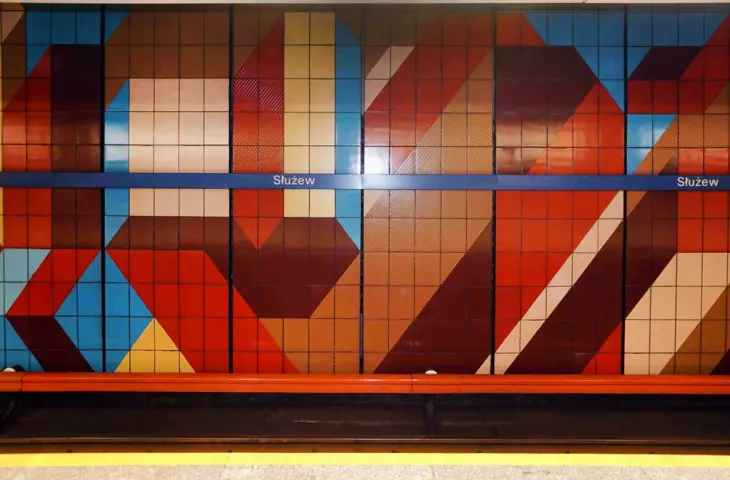At the end of 2022, photos of the mosaics at Ursynów and Sluzew stations being destroyed by Warsaw Metro circulated the Internet. The manager decided to cover them up with advertisements, which sparked opposition from community activists and art historians. A year later, the mosaics were added to the register of monuments.
After Muranów Południowy, this is another December entry in the provincial register of postwar monuments. This time, Prof. Jakub Lewicki, the Mazovian Provincial Conservator of Monuments, entered the ceramic cladding of the jambs and the ceramic cladding of the elevator accesses at the platform level, located at the "Ursynów" and "Służew" stations of the first subway line in Warsaw, in the register of movable monuments of the Mazovian province. Proceedings in this case were initiated ex officio at the request of the Time Collectors Association.
Read more: Muranów Południowy estate entered in the register of monuments
Mosaic at Ursynów station
© Mazowieckie WUOZ
The association made its request after Warsaw Metro began replacing advertising media at first-line stations in 2022. The protests were sparked by the obscuring of information with station names and the size of advertisements in the stations of the central section and the obscuring of mosaics in Ursynów. Although the subway press office argued that the ceramic cladding was not damaged, and that the frame was mounted to the joints - it is easy to see the cracks in the tiles caused by the invasive installation of the ads on the photographic documentation from that period. The listed decoration is the only fully realized element of the station design of the first section of the Warsaw subway. Its main designer in the 1980s was Jasna Strzałkowska-Ryszka, whose team was selected in a competition. According to her concept, the color scheme of the station was to become warmer and warmer as it approached the center.
Along with the Dnipro system, the Warsaw Metro is one of two systems designed with major support from Soviet engineers that were planned in the early 1980s. The resumption of work on the Warsaw railroad was announced in January 1982 - part of an aid package aimed at keeping Poland in the Soviet sphere of influence. A similar situation had already taken place in Prague, where after the suppression of the Prague Spring, the city received an extravagantly designed futuristic subway. Although most of the technology was Soviet, the designers, borrowed ideas from Stockholm, Vienna and Kharkov. This can be clearly seen in the 1995 stations. The huge proportions of Wilanowska, Pola Mokotowskie or Wierzbno, as well as the abstract mosaics in Ursynów, Natolin and Służew, hark back to a time when the subway was treated as a total work of art and engineering.
A mosaic at Sluzew station
© Mazowieckie WUOZ
The decorations of both subway stations are priceless and unique testimonies of modern art from the patronage of the oppressive state. As independent works of art, they testify to the propaganda dimension of the realization of the subway, which, for economic reasons, only opened in 1995. The artwork, realized in the 1990s as part of an investment from the early 1980s, belongs historically to the previous era - the People's Republic of Poland - and is directly related to the events of Martial Law, explains Prof. Jakub Lewicki, Mazovian WUOZ.
Placed at the "Ursynów" and "Służew" stations, the ceramic cladding of the jam walls and the ceramic cladding of the elevator accesses are composed in an analogous manner. The tiles are rectangular, sometimes triangular in shape. The designer repeatedly stressed how difficult it was to enforce the appropriate formats and quality of tiles from the Opoczno plant. The cladding at the Ursynów station is in reds, yellows, browns and oranges with gray accents.
Sluzew subway station in Warsaw
Photo: Adrian Grycuk | © Wikimedia Commons (CC BY-SA 3.0 pl)
The decoration at the Sluzew station is dominated by shades of yellow, red, brown and blue. The elevator accesses are lined with repetitive tiles of a single color, mimicking the tectonics of the corridors. At the "Ursynów" station, the elevator accesses are paved with red, grooved tiles, while at the "Sluzew" station they are - maroon , smooth ones. The author of the mosaic design at Sluzew station is Krzysztof Jachiewicz, and at Ursynów station - Andrzej Drzewiecki.
The mosaic at Ursynów station
© Mazowieckie WUOZ
The artistic value is based on the incorporation of the artwork - the ceramic cladding of the jam wall and elevator accesses - into the space of the platform halls and elevator accesses. The authors designed it as a system of abstract, diagonal compositions that emphasized the dynamics of the entire space. The artwork operates with both color and texture - some of the tiles are grooved, which emphasizes the expressive character - especially when identical tiles form larger mosaics.
Ursynów subway station in Warsaw
Photo: Adrian Grycuk | © Wikimedia Commons (CC BY-SA 3.0 en)
The analogy and pattern for the cladding of the jammed walls can be looked for in the art of the 1920s, especially in Henryk Berlewie's theory of mechanofaktura, against which the works were supposed to move away from spatial illusion in favor of emphasizing the two-dimensionality of the image. The ceramic cladding in the platform part of the "Ursynów" and "Służew" stations has the status of a rarity (only two ceramic decorations from the overall artistic concept of the subway - the only such system in Poland), which started the tradition of thinking of the subway in Warsaw as an underground and publicly accessible art gallery.

































